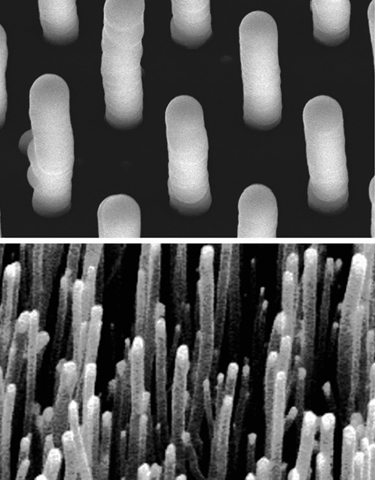(Beyond Pesticides, June 2, 2011) New threats by Monsanto have led to the filing of an amended complaint by the Public Patent Foundation (PUBPAT) in its suit on behalf of family farmers, seed businesses, and organic agricultural organizations challenging Monsanto’s patents on genetically modified seed. Twenty-three new plaintiffs, including Beyond Pesticides, have joined with the original 60 in the amended complaint, bringing the total number represented in the case to 83. The plaintiffs in the suit, Organic Seed Growers and Trade Association (OSGATA), et al. v. Monsanto and pending in the Southern District of New York, now include 36 family farmer, food, agricultural research, food safety, and environmental organizations representing hundreds of thousands of members including several thousand certified organic, biodynamic, or otherwise non-transgenic family farmers.
“Our clients don’t want a fight with Monsanto, they just want to be protected from the threat they will be contaminated by Monsanto’s genetically modified seed and then be accused of patent infringement,” said PUBPAT Executive Director Daniel B. Ravicher. “We asked Monsanto to give our clients reassurance they wouldn’t do such a thing, and in response they chose instead to reiterate the same implicit threat to organic agriculture made in the past.”
Soon after the March filing of the lawsuit, Monsanto issued a statement saying it would not assert its patents against farmers who suffer “trace” amounts of transgenic contamination. In response, and in the hope that the matter could be resolved out of court, PUBPAT attorneys wrote Monsanto’s attorneys asking the company to make its promise legally binding. Monsanto responded to PUBPAT’s request by hiring former solicitor general, Seth P. Waxman, a partner in the Washington, D.C. office of WilmerHale, who rejected PUBPAT’s request and instead confirmed Monsanto may indeed make claims of patent infringement against organic farmers who become contaminated by Monsanto’s genetically modified seed. Copies of both letters are available as exhibits at the end of the amended complaint.
“Monsanto’s letter was an empty, indefensible, and self-evident evasion showing they are only interested in spinning propaganda without taking serious steps to resolve the problem created for organic and non-transgenic agriculture,” said one of the co-plaintiffs in the suit, Don Patterson of Virginia. “With the Monsanto letter signed by Mr. Waxman, the company rolled out their biggest legal cannon, but they fired off only fluffy wadding and smoke,” as he views it. “The letter shows Monsanto wanting to protect their freedom to threaten farmers with patent infringement suits,” he states; “Both the threats and the lawsuits are clearly important to their marketing strategy and business model.”
“Despite their empty propaganda to the contrary, they plainly do not want to give up these tactics,” Mr. Patterson asserts. “Monsanto has collected multiple millions of dollars in settlements often from family farmers without the resources to defend themselves,” he reports; “Too many have had to settle because they could not afford to fight.”
“The serious issues being engaged in this case require a constructive and socially-acceptable response from the defendant in the public interest,” adds Maine farmer Jim Gerritsen, President of OSGATA, the lead plaintiff in the suit. “In the absence of that, we reassert the essential importance of the arguments stated in March and reinforced now by the additional evidence of the Monsanto intransigence. Monsanto’s utter failure to act reasonably to address our concerns has only reaffirmed the need for our lawsuit.”
“We don’t think we are asking too much to want assurance that if Monsanto’s transgenic genes contaminate our crops we will not be sued by Monsanto,” adds Iowa organic dairy farmer Francis Thicke, owner of plaintiff Radiance Dairy; “It is bad enough that we face the threat of contamination of our organic and non-transgenic crops. The least Monsanto can do is give us assurance that they won’t sue us for their own genetic trespass.”
The amended complaint elaborates a fear tangibly vexing many family farmers: “Monsanto continued in the statement to perversely characterize this suit as an ‘attack,’ when Plaintiffs seek no money from and no injunction against them. All Plaintiffs seek is peace of mind if they are ever contaminated by Monsanto’s transgenic seed, the company could never sue them for patent infringement. This is not an attack by the Plaintiffs and to characterize it that way only further evidences Monsanto’s aggressive and threatening attitude with respect to its patents. Thus, the statement made by Monsanto in response to this suit has only served to heighten Plaintiff’s fear that Monsanto will seek to enforce its patents against them should they ever be contaminated by Monsanto’s transgenic seed.”
“It is outrageous that our entire farm, family business, and livelihood could be at risk because of Monsanto’s backward and oppressive response and enforcement towards farmers in regards to transgenic pollen drift, unasked for and unwanted-and the subsequent results in fields and farms,” says Ruth Chantry of Common Good Farm in Nebraska; “Any transgenic pollen drift that would ever come onto our farm is of great detriment to us, and as such, it is an invasion upon and a contamination of our crops, the multi-species habitat we are assisting and creating here-and to the integrity of how we are farming organically and biodynamically.”
The request for court protection through a declaratory judgment is a primary objective of the case. The suit also argues the invalidity of Monsanto’s transgenic Roundup Ready patents under both statute and case law precedent requiring patented products to demonstrate clear social utility and not be dangerous to health. Four basic contentions, ranging from the patent invalidity, through the establishment of proper requirements for a finding of patent infringement to patent unenforceability and Monsanto’s lack of entitlement to collect damages were asserted in the original complaint filed March 29, 2011. Court relief is being sought to protect organic farmers and other growers of non-transgenic crops from liability should unwanted transgenic contamination occur in their fields. The response to the PubPat letter of April 18 was received on April 28 from the Monsanto attorneys. When no binding legal covenant was provided, Ravicher states, the filing of the amended complaint was required to make the defendant’s position fully clear. “The reply from Monsanto is insufficient and unsatisfactory to protect the interests of my clients,” said Mr. Ravicher.
“If organic farmers, seed growers, and companies have no assurance that technology they have never asked for, never signed a licensing agreement to use, have no desire to be a part of, and in fact, go to great lengths to avoid, can still trespass on their farms and subject them to a lawsuit by the patent holder who seemingly escapes all liability for that trespass, then it is not only morally wrong, ethically unjust, but also legally perverse,” states Marty Mesh, Executive Director of Florida Organic Growers.
The biotech impact on the quality, safety, and nutritional integrity of food will be brought up for public and courtroom scrutiny, so that the truth can be determined between their arguments and ours, states Mr. Ravicher; “If Monsanto is proud of what they do, they should be happy for the opportunity to present the evidence in support of their ideal.” To help stimulate and promote objective debate between the differing agricultural philosophies, the new group of plaintiffs has joined the case as part of today’s filing. Included among these are groups long committed to food safety and environmental responsibility in the public interest. Some of the new plaintiffs have been prominent in other legal actions and advocacy against Monsanto’s efforts to aggressively and monopolistically assert its chemically and transgenically-dependent agricultural system.
In addition to supplementing the complaint with Monsanto’s most recent clarifying statement confirming its threat to the plaintiffs and GMO-free agriculture, the new group of 23 organizations, seed companies, farms and individual farmers includes 14 organizations: Weston A. Price Foundation, Center for Food Safety, Beyond Pesticides, Northeast Organic Farming Association of Rhode Island, Northeast Organic Farming Association of New Hampshire, Northeast Organic Farming Association of Connecticut, Northeast Organic Farming Association of New York, Western Organic Dairy Producers Alliance, Manitoba Organic Alliance, Michael Fields Agricultural Institute (Wisconsin), Midwest Organic Dairy Producers Alliance, Florida Organic Growers, Peace River Organic Producers Association (Alberta and British Columbia) and Union Paysanne (Quebec); two seed companies: Seed We Need (Montana), Wild Garden Seed (Oregon); and seven farms or individual farmers: Common Good Farm, LLC (Nebraska), American Buffalo Company (Nebraska), Full Moon Farm, Inc. (Vermont), Radiance Dairy (Iowa), Brian L. Wickert (Wisconsin), Bruce Drinkman (Wisconsin), and Murray Bast (Ontario).
These plaintiffs join the 60 plaintiffs from the original filing of the lawsuit in March including 22 organizations: Organic Seed Growers and Trade Association; Organic Crop Improvement Association International, Inc. (OCIA); OCIA Research and Education, Inc.; The Cornucopia Institute; Demeter Association, Inc.; Navdanya International; Maine Organic Farmers and Gardeners Association; Northeast Organic Farming Association/Massachusetts Chapter, Inc.; Northeast Organic Farming Association of Vermont; Rural Vermont; Ohio Ecological Food & Farm Association; Southeast Iowa Organic Association; Northern Plains Sustainable Agriculture Society; Mendocino Organic Network (California); Northeast Organic Dairy Producers Alliance; Canadian Organic Growers; Family Farmer Seed Cooperative; Sustainable Living Systems (Montana); Global Organic Alliance; Food Democracy Now!; Family Farm Defenders, Inc.; Farm-to-Consumer Legal Defense Fund; twelve seed companies: FEDCO Seeds, Inc. (Maine); Adaptive Seeds, LLC (Oregon); Sow True Seed (North Carolina); Southern Exposure Seed Exchange (Virginia); Mumm’s Sprouting Seeds (Saskatchewan); Baker Creek Heirloom Seed Co., LLC (Missouri); Comstock, Ferre & Co. LLC (Connecticut); Seedkeepers, LLC (California); Siskiyou Seeds (Oregon); Countryside Organics (Virginia); Cuatro Puertas (New Mexico); Interlake Forage Seeds, Ltd. (Manitoba); and, twenty-six farms and farmers: Alba Ranch (Kansas); Wild Plum Farm (Montana); Gratitude Gardens (Washington); Richard Everett Farm, LLC (Nebraska); Philadelphia Community Farm, Inc. (Wisconsin); Genesis Farm (New Jersey); Chispas Farms, LLC (New Mexico); Kirschenmann Family Farms, Inc. (North Dakota); Midheaven Farms (Minnesota); Koskan Farms (South Dakota); California Cloverleaf Farms; North Outback Farm (North Dakota); Taylor Farms, Inc. (Utah); Jardin del Alma (New Mexico); Ron Gargasz Organic Farms (Pennsylvania); Abundant Acres (Missouri); T & D Willey Farms (California); Quinella Ranch (Saskatchewan); Nature’s Way Farm, Ltd. (Alberta); Levke and Peter Eggers Farm (Alberta); Frey Vineyards, Ltd. (California); Bryce Stephens (Kansas); Chuck Noble (South Dakota); LaRhea Pepper (Texas); Paul Romero (New Mexico); and, Donald Wright Patterson, Jr. (Virginia).
Beyond Pesticides is currently involved with another lawsuit concerning GE crops led by attorneys for the Center for Food Safety (CFS), Earthjustice, and farm and environmental groups. The lawsuit filed against the U.S. Department of Agriculture (USDA), argues that the agency’s recent unrestricted approval of GE alfalfa is unlawful.
More information about PUBPAT’s suit against Monsanto’s seed patents can be found at PUBPAT’s page on Monsanto Seed Patents.
Source: Organic Seed Growers and Trade Association Press Release

















